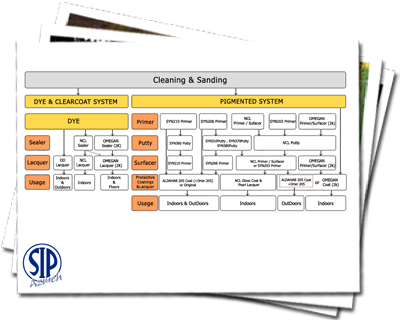Wooden Surfaces Coatings Systems
Coating performance is, in general, proportional to the degree of surface preparation. Prior to coating, wooden surfaces should be clean, dry, free from dirt, wax, grease, and other foreign matter. In general wooden surfaces require sanding but in some cases they may also have cracks or holes that need to be filled or sealed. Another decisive factor for coating successfulness is the use of correct paint system according to the specific end use requirements. For interior use, wood requires coating in order to enhance and preserve the decorative and aesthetic appeal, as well as to improve its ability to withstand abrasion and wear. Flooring applications require coatings that are impact and abrasion resistant. For exterior use, the prime requirement of wood is the ability to protect the substrate from water and the damaging effects of ultra-violet light.
CLEANING and SANDINGPrior to coating, wooden surfaces should be clean and dry. Hot air is used to remove moisture from wood. Sanding is used either manually or by the use of a power sander with a fine to medium sandpaper to remove all loose fibrous materials. Sanding residue must be removed prior to coating. Any trace of oil and grease can be removed from the surface with white spirit. Allow cleaned surfaces to dry.
OIL TREATMENT Of WOODEN SUBSTRATESSome kinds of wood usually present a problem when trying to color or stain. Some apparently random areas on the surface of the wood absorb more color, leaving dark blotches "especially when using dark stain" for that reason it is recommended to treat the wood using Woodtreat prior to staining. Woodtreat contains special oils to control stain penetration and additives to protect wood and inhibit mildew growth on coating surface.
COATINGTwo different processes can be used for the protection of wooden surfaces: A- DYE & CLEARCOAT SYSTEM (refer to substrate treatment of wooden surfaces diagram)
B- PIGMENTED SYSTEM (refer to substrate treatment of wooden surfaces diagram)
Different full paint systems are available as is shown in the substrate treatment of wooden surfaces diagram. The choice of a process for substrate treatment and coating depends on different factors such as interior or exterior use, furniture, flooring (parquet) etc…
|
|
Substrate Treatment Of Wooden Surfaces
|
